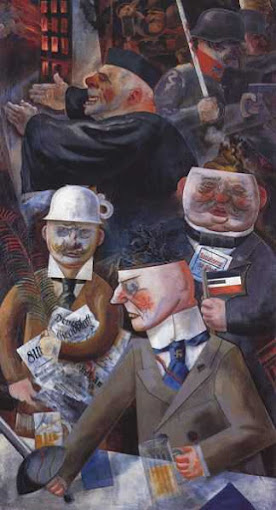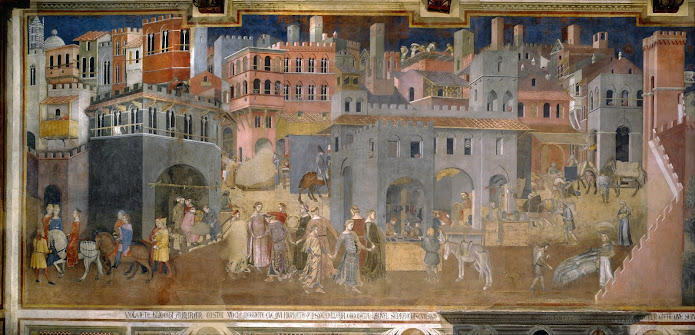Dada and the Influence of WWI
Early Modern - Dada Exhibit
 |
| The Pillars of Society - George Grosz |
Since the Dada movement was one born of dislike to the art standards of that time, one may think the elements we know of aren't as present, but I still find them to be in this painting. Something Grosz did in a unique way with this, is spacing, he made a very crowded painting have a lot of depth, while still being crowded, while using shape and texture to accentuate the traits of the four figures. I like this painting and, I find it to be one that shows off a deeper part of humanity, and how people will always sway towards greed, resulting in corruption. The way the overall painting comes together gives me a feeling of frustration as something like this is so harsh, yet true.
 |
| Object to Be Destroyed - Man Ray |
This next Dada work, is a bit out of the box, but does a good job showcasing just what kind of stuff these people were all about. This piece is exactly what it looks like, no gimmicks or higher functions, just a metronome with a picture of an eye glued to it. This is more of a product of the movement than a reaction to the climate after WWI, but what I like about this, is you can totally get away with making your own interpretation to this. For some people they could see it as someone watching over them, for others it could be a reactionary piece about how the government watches you. One key Dada idea this project brought up was how it was made to be destroyed, when the concept of temporary art was not one people were familiar with. Dada artists would often publish journals explaining their works, and in one there were instructions on how to create your own object to be destroyed, by attaching a photograph of someones eye "who has been loved but is seen no more" (This Quarter, 1932), to a metronome. This brings me back to the interpretations of this project and how it could be someone watching over you. Depending on the eye you cut out and place on the metronome, the meaning changes, it could be someone who has passed away and that could provide comfort, or it could be an enemy who is challenging you to preform your best.
Elements
With this sculpture the obvious elements would be the shape, form and texture if you wanted to look into that aspect of it. I find it ironic that in an art class I am analyzing this piece by looking at the elements which we judge and compare all other types of art to, when the point of this art was to resist that and speaking out against it, at the cost of absurdity. There is no deeper meaning to the shape of it, the fact that this metronome, like most others at this time was the shape of a pyramid has no effect on the meaning of it. I suppose if you really wanted to look into this you could say that the lack of elements is one of the things that stands out, Ray wasn't trying to make this be something it wasn't. He could've painted it or modified it or changed it, so people wouldn't see the simplicity of it, but as it was a counter-culture movement, he had nothing to hide.
While this might not be as direct as the first piece we looked at, I think that because of the art climate after World War I, Duchamp wanted to push the boundaries of what people were considering art. All he did was purchase a urinal, flip it upside down and sign it. His motives could have been that he saw how people were talking about art when there wasn't much there and he wanted to see the reaction if he truly put nothing there. The feeling and culture of this piece are still out there in all things created. Take music for example, there are many top charting songs that are extremely lacking in substance, message, and overall quality, but people are labeling them as something great and new, when it's just the same thing over and over again. If someone were to make a 'song' that is just static, that would be the equivalent. The feelings Duchamp and other Dada artist had about the war and art climate, are reflected in the culture and story of "Fountain".
Elements(ish)
While this piece doesn't have traditional artist created elements, the choice of a urinal, inverting it, and calling it art, are using the same rules as choosing something like a brush stroke or where to add shadows; it's all freedom of the artists, the difference is this provokes the question: What is art?
My Thoughts
I find the Dada movement fascinating, as a reaction of the war and things that followed it, it offered responses, even if they were rejected by many. This is the first kind of protest centered work that we have looked at in this class, and while some of it is hard to understand, I like the history around the movement. My favorite piece I covered in this blog has to be Man Ray's Object to Be Destroyed, as the idea that art is temporary and fully up to interpretation.
Resources
Alfred Hugenberg. 31 Mar. 2021, en.wikipedia.org/wiki/Alfred_Hugenberg.
Dadaism - Art and Anti Art, www.artyfactory.com/art_appreciation/art_movements/dadaism.htm.
“Friedrich Ebert.” Wikipedia, Wikimedia Foundation, 18 Mar. 2021, en.wikipedia.org/wiki/Friedrich_Ebert.
jonathan5485, Author. “The Pillars of Society by George Grosz.” My Daily Art Display, 22 Jan. 2011, mydailyartdisplay.wordpress.com/2011/01/22/the-pillars-of-society-by-george-grosz-3/.
Tate. “'Fountain', Marcel Duchamp, 1917, Replica 1964.” Tate, www.tate.org.uk/art/artworks/duchamp-fountain-t07573.
“MoMA Learning.” MoMA, www.moma.org/learn/moma_learning/man-ray-indestructible-object-1964-replica-of-1923-original/.




For a movement that emerged during the period of war, the Dada style really allowed artists to break from the traditional rules of art creation and gave them freedom with their artistic liberty. Works from the Dada movement possessed such uniqueness, especially as it rejected by many traditional art elements, and I find it cool that it wasn't solely limited to paintings, but rather also forms of art media. Like sculptures and photographs. I also really liked how you focused on different forms of Dada works, showing how there were no real limitations in the movement, and how this style makes us question what exactly defines art. Everything was really informative and well explained. Great Post!
ReplyDelete